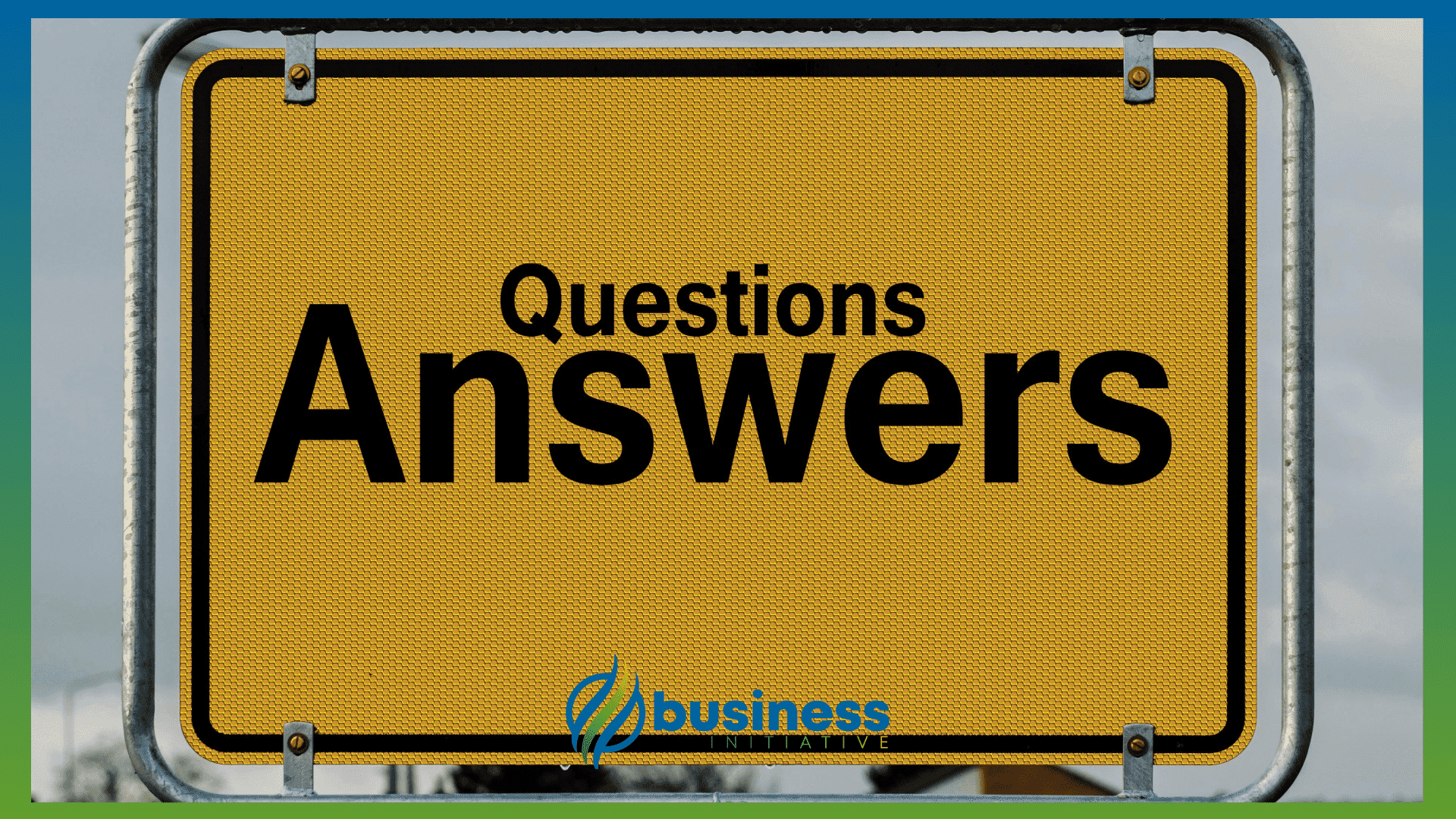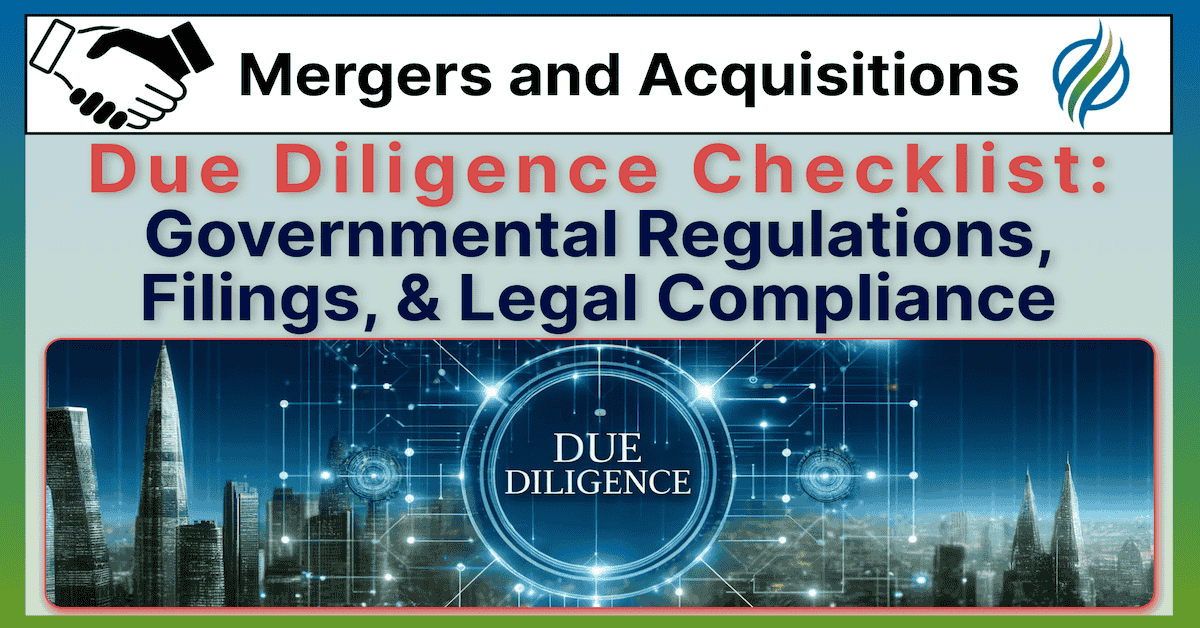Understanding government regulations and legal compliance is crucial for successful mergers and acquisitions (M&A).
This guide explains everything you need to know about due diligence in this area.
It covers reviewing citations, assessing investigations, evaluating correspondence with government entities, verifying certifications, and analyzing compliance costs.
 Key Takeaways
Key Takeaways
- Review citations to identify regulatory issues and liabilities.
- Assess pending investigations to understand potential legal risks and financial impacts.
- Evaluate correspondence with government entities for compliance insights.
- Verify compliance certifications to ensure adherence to regulations.
- Analyze regulatory compliance costs to manage financial impacts and identify savings.
Why is this important?
It helps you avoid legal pitfalls, minimize risks, and ensure a smooth acquisition process.
To get the most out of this article, follow the practical steps and self-assessment questions provided in each section.
They offer clear, actionable advice to navigate the complexities of regulatory compliance.
Ready to dive in? Keep reading to master the essentials of M&A due diligence and safeguard your investment.
 Table of Contents
Table of Contents
Understanding the extent to which the target company adheres to regulatory requirements is crucial for the buyer.
This involves a comprehensive review of citations, pending investigations, and other regulatory matters.
Ensuring compliance not only minimizes legal risks but also enhances the company’s reputation and operational stability.

➤ MORE: Check out the FULL Due Diligence Checklist here
Review Citations and Notices from Government Agencies:
Reviewing citations and notices received from government agencies is essential to identify any regulatory compliance issues and potential liabilities.
This process provides insight into past regulatory interactions and highlights areas of concern that may impact the acquisition.
Practical Benefits:
-
Identifies potential legal liabilities.
-
Highlights areas needing immediate attention.
-
Provides a clear picture of the company’s regulatory history.
Importance:
-
Ensures all past issues are resolved.
-
Prevents future regulatory breaches.
-
Builds trust and transparency in the acquisition process.
Practical Steps:
-
Gather Documentation: Collect all citations and notices received from government agencies over the past several years.
-
Analyze Responses: Review how the company has responded to these citations and notices, focusing on resolution actions and timelines.
-
Identify Unresolved Issues: Determine if there are any unresolved citations or ongoing investigations and assess their potential impact on operations.
-
Evaluate Frequency: Analyze the frequency of such citations to understand the company’s compliance track record.
Self-Assessment Questions:
-
What citations or notices has the company received from government agencies?
-
How has the company responded to these citations or notices?
-
Are there any unresolved issues or ongoing investigations?
-
What impact could these issues have on the company’s operations?
-
How frequently does the company receive such citations?
-
Government Agency Websites
Assess Pending or Threatened Investigations:
Identifying any pending or threatened investigations involving the company is critical to understanding potential legal risks and their financial implications.
This assessment helps in anticipating future challenges and preparing for possible legal battles.
Practical Benefits:
-
Foresees potential legal costs.
-
Assesses risk exposure.
-
Plans for mitigation strategies.
Importance:
-
Prevents unexpected financial burdens.
-
Helps in strategic planning.
-
Ensures informed decision-making.
Practical Steps:
-
Identify Investigations: Compile a list of all pending or threatened investigations.
-
Understand Key Issues: Investigate the core issues of each case to assess their severity.
-
Evaluate Financial Impact: Estimate the potential financial impact of these investigations on the company’s finances.
-
Assess Preparedness: Review the company’s readiness to handle these investigations, including legal resources and strategies in place.
-
Identify Patterns: Look for recurring themes or patterns in the investigations to understand systemic issues.
Self-Assessment Questions:
-
Are there any pending or threatened investigations against the company?
-
What are the key issues being investigated?
-
What is the potential financial impact of these investigations?
-
How prepared is the company to handle these investigations?
-
Are there any patterns or recurring themes in the investigations?
-
Company’s Legal Department
Evaluate Material Reports and Correspondence with Government Entities:
Reviewing material reports and correspondence with government entities is vital to assess the company’s regulatory compliance and identify any potential issues.
This includes communications with municipalities or agencies that may impact operations.
Practical Benefits:
-
Ensures comprehensive understanding of regulatory interactions.
-
Identifies ongoing compliance issues.
-
Facilitates proactive management of regulatory relationships.
Importance:
-
Provides transparency in regulatory matters.
-
Highlights compliance strengths and weaknesses.
-
Supports informed decision-making.
Practical Steps:
-
Collect Reports: Obtain all material reports and correspondence with government entities.
-
Analyze Issues: Identify any significant issues raised in these communications and assess their potential impact.
-
Review Responses: Evaluate how the company has addressed these issues and any follow-up actions taken.
-
Identify Ongoing Discussions: Note any ongoing discussions or negotiations with regulatory bodies to understand their current status and future implications.
Self-Assessment Questions:
-
What reports and correspondence exist with government entities?
-
Are there any significant issues raised in these communications?
-
How does the company address regulatory compliance issues?
-
Are there any ongoing discussions or negotiations with regulatory bodies?
-
Government Agency Websites
Verify Certification of Compliance:
Obtaining documents showing certification of compliance with regulatory standards ensures the company adheres to necessary regulations.
This verification process is crucial for maintaining legal and operational integrity.
Practical Benefits:
-
Confirms compliance with industry standards.
-
Reduces risk of regulatory fines and penalties.
-
Enhances credibility and trust.
Importance:
-
Ensures ongoing regulatory adherence.
-
Demonstrates commitment to legal standards.
-
Facilitates smooth business operations.
Practical Steps:
-
Collect Certifications: Obtain all required certifications of compliance from the company.
-
Review Validity: Check the validity of these certifications and ensure they are up-to-date.
-
Identify Issues: Identify any issues or violations related to these certifications and understand their implications.
-
Evaluate Maintenance Processes: Assess the company’s process for maintaining compliance, including regular reviews and updates of certifications.
Self-Assessment Questions:
-
Does the company have all required certifications of compliance?
-
How frequently are these certifications reviewed and updated?
-
Are there any issues or violations related to these certifications?
-
What is the process for maintaining compliance with regulatory standards?
-
Regulatory Compliance Advisors
Assess Costs of Regulatory Compliance:
Reviewing reports on the burdens and costs of regulatory compliance, including labor, environmental, and other federal, state, and local regulations, helps understand the financial impact of maintaining compliance.
This analysis is vital for effective financial planning and management.
Practical Benefits:
-
Identifies major compliance cost drivers.
-
Finds opportunities for cost savings.
-
Enhances budget planning.
Importance:
-
Ensures accurate financial forecasting.
-
Manages compliance costs effectively.
-
Improves overall financial health.
Practical Steps:
-
Gather Reports: Collect detailed reports on the costs associated with regulatory compliance.
-
Analyze Costs: Break down the costs into categories such as labor, environmental, and other regulatory expenses.
-
Identify Savings Opportunities: Look for areas where the company can optimize processes to reduce compliance costs.
-
Compare Industry Standards: Compare the company’s compliance costs with industry standards to benchmark efficiency.
Self-Assessment Questions:
-
What are the main costs associated with regulatory compliance?
-
How does the company manage these costs?
-
Are there any cost-saving opportunities in compliance processes?
-
How do these compliance costs compare to industry standards?
-
Company’s Compliance Reports
FAQs - Frequently Asked Questions About Investigating a Company’s Legal and Regulatory Compliance

Why is regulatory compliance important in M&A due diligence?
It minimizes legal risks and ensures smooth operations.
Non-compliance can lead to fines and operational disruptions.
Learn More...
Regulatory compliance is critical in M&A due diligence because it minimizes legal risks, ensuring that the company operates within the law.
This helps in avoiding fines, penalties, and operational disruptions that can arise from non-compliance.
Ensuring regulatory compliance during due diligence provides a clear picture of the target company’s legal standing and potential liabilities.
It helps in identifying any past or ongoing compliance issues that could impact the acquisition process and future operations.
For instance, non-compliance with environmental regulations can lead to significant fines and reputational damage.
What are the steps to verify compliance certifications?
Collect and review all relevant compliance documents.
Check the validity and ensure they are up-to-date.
Learn More...
The first step in verifying compliance certifications is to collect all relevant documents from the target company.
These include certifications related to industry-specific regulations, health and safety standards, and environmental compliance.
Next, review the validity of these certifications to ensure they are current and have not expired.
Investigate any issues or violations related to these certifications and assess the company's process for maintaining compliance.
This might include regular reviews, updates, and internal audits to ensure ongoing adherence to regulatory standards.
How can I assess the costs of regulatory compliance?
Collect detailed reports on compliance costs.
Analyze costs by category and compare with industry standards.
Learn More...
To assess the costs of regulatory compliance, start by collecting detailed reports on all associated costs.
This includes labor, environmental, and other regulatory expenses.
Analyze these costs by category to understand the major cost drivers.
Look for opportunities to optimize processes and reduce expenses.
Comparing these costs with industry standards can provide insights into whether the company is spending efficiently or if there are areas for improvement.
What should I look for in government citations and notices?
Identify any regulatory compliance issues.
Assess the company's responses to these citations.
Learn More...
When reviewing government citations and notices, identify any regulatory compliance issues that have been highlighted by regulatory agencies.
These citations can provide valuable insights into areas where the company may have previously failed to comply with regulations.
Assess how the company responded to these citations, including the steps taken to rectify the issues and prevent future occurrences.
Understanding the frequency and nature of these citations can help you gauge the company’s overall compliance track record and potential risks.
Why is it important to assess pending or threatened investigations?
It helps understand potential legal risks.
Prepares you for possible financial impacts.
Learn More...
Assessing pending or threatened investigations is crucial because it helps you understand the potential legal risks the target company faces.
This includes identifying the core issues being investigated and their severity.
Understanding these investigations prepares you for possible financial impacts, such as legal fees, fines, or settlements.
It also helps you evaluate the company’s preparedness in handling these investigations, including their legal resources and strategies in place.
How do I evaluate correspondence with government entities?
Review all material reports and correspondence.
Identify significant issues and how they are addressed.
Learn More...
Evaluating correspondence with government entities involves reviewing all material reports and communications between the company and regulatory bodies.
This can provide insights into the company’s compliance efforts and any regulatory challenges they face.
Identify any significant issues raised in these communications and assess how the company has addressed them.
This helps you understand ongoing discussions or negotiations with regulatory bodies and the company’s approach to maintaining compliance.
It's important to note any recurring themes or issues that might indicate systemic problems within the organization.
What resources can help with M&A due diligence on regulatory compliance?
Use legal research tools like LexisNexis and Westlaw.
Consult regulatory compliance advisors.
Learn More...
For comprehensive legal research, tools like LexisNexis and Westlaw are invaluable.
These platforms provide access to a vast array of legal documents, case law, and regulatory information that can aid in due diligence.
Consulting regulatory compliance advisors can provide expert guidance tailored to your specific industry and needs.
These advisors can help navigate complex regulations and ensure thorough compliance checks.
Additionally, government agency websites often provide valuable resources and updates on regulatory requirements relevant to your business.
In Summary…
Navigating governmental regulations and ensuring legal compliance are crucial components of successful mergers and acquisitions (M&A).
This article has outlined key steps for thorough due diligence, including reviewing citations and notices, assessing pending investigations, evaluating correspondence with government entities, verifying compliance certifications, and analyzing regulatory compliance costs.
By applying this information, you gain the ability to identify potential legal liabilities, understand regulatory risks, and manage compliance costs effectively.
This not only helps in mitigating risks but also ensures a smoother and more transparent acquisition process.
Being well-prepared in these areas builds trust with stakeholders and can significantly enhance the success of your M&A endeavors.
Practical Application:
-
Identify Regulatory Issues: Regularly review citations and notices to proactively address any compliance issues.
-
Understand Legal Risks: Keep track of pending investigations to anticipate and prepare for potential legal challenges.
-
Maintain Compliance: Ensure all required certifications are up-to-date and address any issues promptly.
-
Manage Costs: Analyze compliance costs to find savings and improve financial planning.
By integrating these practices, you can safeguard your investment, enhance operational stability, and ensure a seamless acquisition process.
Ready to take the next step?
Schedule a consultation call with us or use our contact form to get personalized advice and support for your M&A process.
Stay informed and ahead of the curve by subscribing to our Initiative Newsletter.
Follow us on X for the latest updates and insights.
Act now to secure your business’s future with strategic M&A due diligence.
Sources
- LexisNexis: For comprehensive legal research.
- Westlaw: For comprehensive legal research.
- SEC EDGAR Database: For publicly traded companies' financial filings.
- U.S. Department of Labor: For labor regulations and compliance information.
- Environmental Protection Agency (EPA): For environmental regulations and compliance guidelines.
- Federal Trade Commission (FTC): For antitrust laws and compliance information.
- Occupational Safety and Health Administration (OSHA): For workplace safety regulations and compliance standards.
- Food and Drug Administration (FDA): For compliance standards in the food and pharmaceutical industries.
- Commodity Futures Trading Commission (CFTC): For compliance information on commodity futures and options markets.


